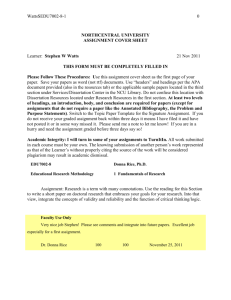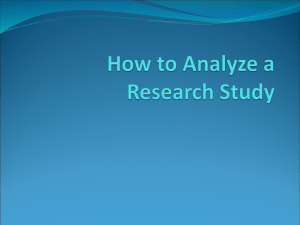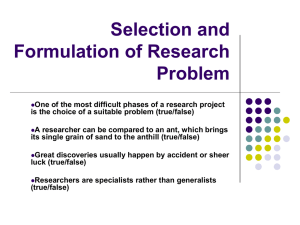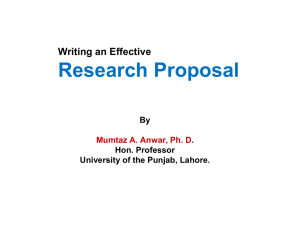Business Research Methods
advertisement
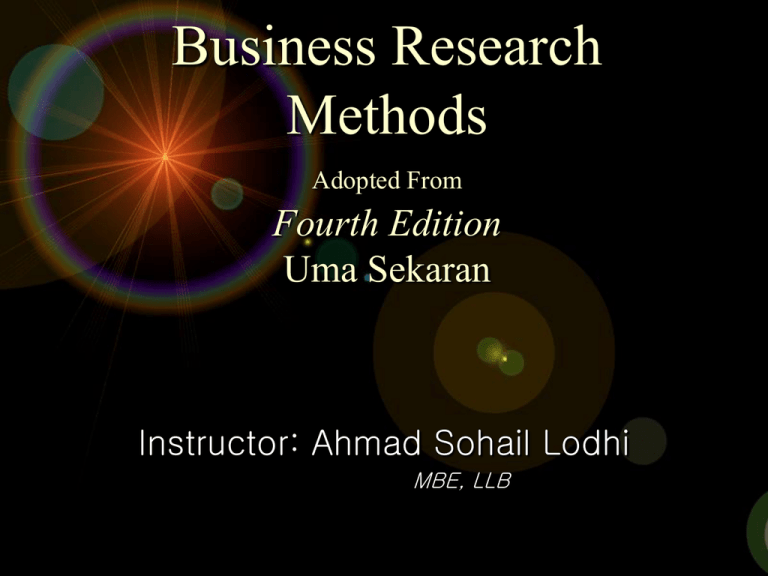
Business Research Methods Adopted From Fourth Edition Uma Sekaran Instructor: Ahmad Sohail Lodhi MBE, LLB Chapter 2 SCIENTIFIC INVESTIGATION After completing this chapter you would be able to understand: The Hallmarks of Scientific Research Some obstacles to conducting scientific research in the management area The building blocks of science in research The hypothetico deductive method Other types of research Definition of Scientific Research Scientific Research focusing on solving problems and pursues a step by step logical, organized and rigorous method to identify the problems, gather data, analyze them and draw valid conclusions there from. Why Scientific Research? This research is not based on hunches, experience and intuition. It is purposive and rigorous. Enables all those who are interested in researching and knowing about the same or similar issues to come up with comparable findings when data are analyzed. Findings are accurate and confident. Apply solutions to similar problems. It is more objective. Cont. Highlights the most critical factors at the work place that need specific attention to solve or minimize problems. Scientific Investigation and Managerial Decision Making are integral part of effective problem solving. It can be applied to both basic and applied research. The Hallmarks of Scientific Research The hallmarks or main distinguishing characteristics of scientific research may be listed as follows: 1. 2. 3. 4. 5. 6. 7. 8. Purposiveness Rigor Testability Replicability Precision and Confidence Objectivity Generalizability Parsimony Hallmarks of Scientific Research 1. Purposiveness It has to start with a definite aim or purpose. The focus is on increasing employee commitment. Increase employee commitment will translate into less turnover, less absenteeism and increased performance levels. Thus it has a purposive focus. 2. Rigor A good theoretical base and sound methodological design would add rigor to the purposive study. Rigor adds carefulness, scrupulousness and the degree of exactitude in research. Example: A manager asks 10-12 employees how to increase the level of commitment. If solely on the basis of their responses the manager reaches several conclusions on how employee commitment can be increases, the whole approach to the investigation would be unscientific. It would lack rigor for the following reasons: Based on few employees 2. Bias and incorrectness 3. There might be other influences on commitment which are ignored and are important for a researcher to know Thus, Rigorous involves good theoretical base and thought out methodology. These factors enable the researcher to collect the right kind of information from an appropriate sample with the minimum degree of bias and facilitate suitable analysis of the data gathered. This supports the other six too. 1. 3. Testability After random selection manager and researcher develops certain hypothesis on how manager employee commitment can be enhanced, then these can be tested by applying certain statistical tests to the data collected for the purpose. The researcher might hypothesize that those employees who perceive greater opportunities for participation in decision making would have a higher level of commitment. 4. Replicability It means that it can be used again if similar circumstances prevails. Example: The study concludes that participation in decision making is one of the most important factors that influences the commitment, we will place more faith and credence in these finding and apply in similar situations. To the extent that this does happen, we will gain confidence in the scientific nature of our research. 5. Precision and Confidence Precision – Precision refers to the closeness of the findings to “reality” based on a sample. – It reflects the degree of accuracy and exactitude of the results of the sample. Example: If a supervisor estimated the number of production days lost during the year due to absenteeism at between 30 and 40, as against the actual of 35, the precision of my estimation more favorably than if he has indicated that the loss of production days was somewhere between 20 and 50. Confidence – Confidence refers to the probability that our estimations are correct. – That is, it is not merely enough to be precise, but it is also important that we can confidently claim that 95% of the time our results would be true and there is only a 5% chance of our being wrong. – This is also known as confidence level. 6. Objectivity The conclusions drawn through the interpretation of the results of data analysis should be objective; that is, they should be based on the facts of the findings derived from actual data, and not on our subjective or emotional values. Example: If we had a hypothesis that stated that greater participation in decision making will increase organizational commitment and this was not supported by the results, it makes no sense if the researcher continues to argue that increased opportunities for employee participation would still help! 7. Generalizability It refers to the scope of applicability of the research findings in one organization setting to other settings. Example: If a researcher’s findings that participation in decision making enhances organizational commitment are found to be true in a variety of manufacturing, industrial and service organizations, and not merely in the particular organization studied by the researcher, then the generalizability of the findings to other organizational settings in enhanced. The more generalizable the research, the greater its usefulness and value. 8. Parsimony Simplicity in explaining the phenomenon or problems that occur, and in generating solutions for the problems, is always preferred to complex research frameworks that consider an unmanageable number of factors. For instance, if 2-3 specific variables in the work situation are identified, which when changed would raise the organizational commitment of the employees by 45%, that would be more useful be more useful and valuable to the manager than if it were recommended that he should change 10 different variables to increase organizational commitment by 48%. The Building Blocks of Science in Research Deduction and Inductions Answers to issues can be found either by the process of induction or the process of induction, or by a combination of the two. Deduction Deduction is the process by which we arrive at a reasoned conclusion by logical generalization of a known fact. Example: we know that all high performers are highly proficient in their jobs. If John is a high performer, we then conclude that he is highly proficient in his job Induction Induction is a process where we observe certain phenomena and on this basis arrive at conclusions. In other words, in induction we logically establish a general proposition based on observed facts. To define or describe the figure. Figure is a five-sided figure enclosing two dots. The Hypothetico-Deductive Method Observation – Observation is the first stage, in which one senses that certain changes are occurring or that some new behaviors, attitudes and feelings are surfacing in one’s environment (i.e., the work place). – How does one observe phenomena and changes in the environment? Preliminary Information Gathering: – It involves the seeking of information in depth, of what is observed. – This could be done by talking informally to several people in the work setting or to clients or to other relevant sources, thereby gathering information on what is happening and why. (Unstructured interviews) – Then it is followed by structured interviews. – Additionally by doing library research or obtaining information through other sources, the investigator would identify how such issues have been tackled in other situations. Theory Formulation – It is an attempt to integrate all the information in a logical manners, so that the factors responsible for the problem can be on conceptualized and tested. – The theoretical framework formulated is often guided by experience and intuition. – In this step the critical variables are identified and examined as to their contribution or influence in explaining why the problem occurs and how it can be solved. Hypothesizing – It is the next logical step after theory formulation. – From the theorized network of associations among the variables, certain testable hypotheses or educated conjectures can be generated. – Hypothesis testing is called deductive research. Sometimes, hypotheses that were not originally formulated do get generated through the process of induction. Further Specific Data Collection –After the development of the hypotheses, data with respect to each variable in the hypotheses need to be obtained. –Further data are collected to test the hypotheses that are generated in the study. Data Analysis – Data gathered are statistically analyzed to see if the hypotheses that were generated have been supported. – Co relational method will be used to analyze and determine the relation ship of two or more factors in the hypotheses for example: stock availability and customer satisfaction. Deduction –Deduction is the process of arriving at conclusions by interpreting the meaning of results of the data analysis. Other Types of Research 1. 2. Case studies and action research are sometimes used to study certain types of issues. Case Studies Action Research Case Studies Case studies involve in depth, contextual analyses of similar situations in the other organizations, where the nature and definition of the problem happen to be the same as experienced in the current situation. Case study, as a problem solving technique, is not often undertaken in organizations because such studies dealing with problems similar to the one experienced by a particular organization of a particular size and in a particular type of setting are difficult to come by. Action Research The researcher begins with a problem that is already identified and gathers relevant data to provide a tentative problem solution. This solution is then implemented, with the knowledge that there may be unintended consequences following such implementation. The effects are then evaluated, defined and diagnosed and the research continues on an ongoing basis until the problem is fully resolved.


